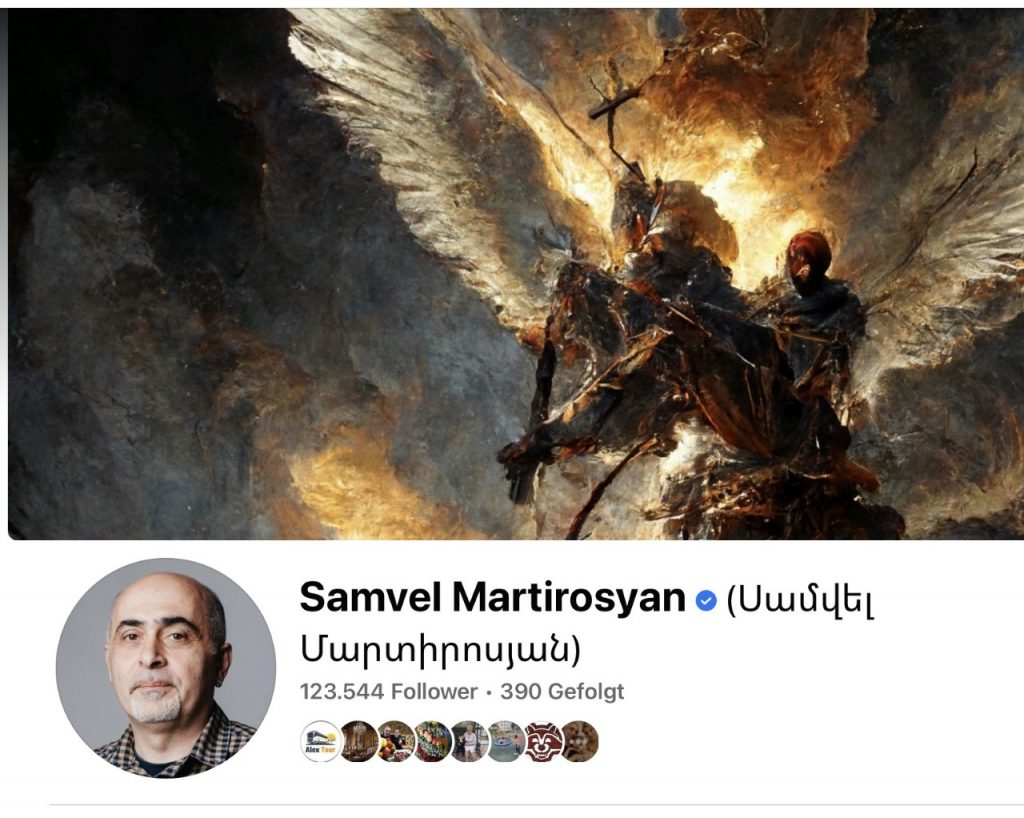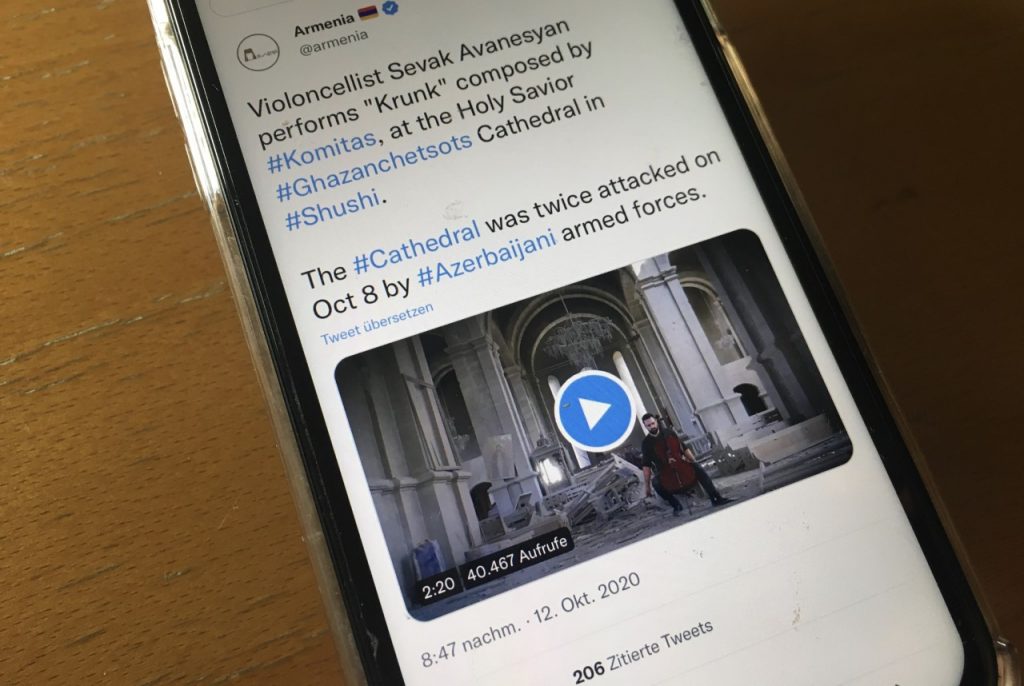The majority of Armenians trust social media over traditional media. People with а large number of followers become opinion makers or influencers impacting public perceptions. While a few political influencers try to do fact-checking, others use their social accounts to tell personal stories of war. But this may sometimes harm society and downgrade security.
by Larissa Mass
Samvel Martirosyan is among the pioneers of Armenian social media, posting mostly on digital security. With over 125 thousand followers on Facebook and around 12,000 on Telegram, Martirsoyan’s audience grew over the years, reaching its peak during the recent Armenian-Azerbaijani war in 2020 over Nagorno-Karabakh. As his research on social media trends in Armenia shows, people who speak about politics and the situation on the front line are more influential. For many people, military-related topics turn out to be more interesting than some young pretty ladies wearing beautiful makeup.

“It’s very strange when you have more influential people from the Ministry of Defense,” Martirosyan says. With one million followers, the biggest number on Armenian Facebook, the country’s Prime Minister Nikol Pashinyan has the lead. For a country that has a population of less than three million people, one million followers on Armenian Facebook is a significant achievement. Martirosyan explains that social media plays a big role in war-related information, as most Armenians grow up believing that the media is always lying: “So you have to discover information between the lines or from somewhere else through rumors. You would never see the media reporting anything negative that occurred in Soviet times since such information was fully restricted. As far as I can recall, the first time when we heard something about a catastrophe, was during the Chernobyl accident. And a week had already passed since the disaster, and it was impossible to block the information because the whole world was already shouting.”
According to Martirosyan, Facebook in Armenia remains as a main platform for socio-political debates. Most of the politicians make public statements predominantly via Facebook. But Telegram is becoming more and more impactful, as the moderation on Facebook is getting tougher.
During the 44-Day War, Anna Naghdalyan was the Armenian Foreign Ministry spokesperson. She confirms that in Armenia about 80% of people get political news from Facebook. This is why the government and the Prime Minister talk to people through Facebook. Officials use Facebook for internal communication. Twitter is used in English for reaching the outside world. Naghdalyan speaks proudly of the work of the Twitter account of Armenia: “Let’s say it’s Armenia’s official account on Twitter. We cannot say it has the biggest number of followers in Armenia, but it is a business card of Armenia, which was created and is still being maintained by the team at the Foreign Ministry.”
Foreign Ministry tells personal stories from the war
Anna Naghdalyan worked out strategies to inform people on social media. Their main idea, as Naghdalyan says, was to tell the stories of people living in the conflict zone: “There is a general perception that a conflict zone is a place where you can have a war, and nobody needs to bear a responsibility for the war crimes happening there now.” She then says she was born in Nagorno-Karabakh, where her family still lives. “I myself once argued whether they want to say that it is okay to kill me because I was born in a conflict zone. They want to say that I have no rights. This is what they don’t realize: there are people living there. And being born in a conflict zone doesn’t make you any way less human than other humans living in other parts of the world. So that’s why we mainly engage with it, using social media to tell these stories happening in that part the world doesn’t want to see.”
During the war they learned a lot about social media strategy, and what kind of content works on diverse platforms. As Naghdalyan puts it, evoking emotions is key to the audience. Two visuals from the war went viral. One was the toy teddy bear photographed in the street following the bombing of Stepanakert. “And this picture went viral as it was eliciting some emotions. There are no people injured, no blood on it. It’s just a toy,” Naghdalyan continues.

The second viral post was from the destroyed main cathedral in Artsakh: it was bombed twice. And after the shelling of the church, an Armenian musician got to the church and played cello. “And the message of this video was that there’s another side of the war. They are people, and these people want peace. They are not like that. We are for peace and civilization, and culture doesn’t need to be killed when there is a war. And this works even way better than any other statement by the Ministry.”
WarTok – the role of TikTok in times of war
As a social media TikTok nowadays plays a significant role. Since 2020, TikTok has also evolved into a platform for political communication among teenagers worldwide: first-time voters in the US in 2020 primarily used TikTok to shape their political beliefs. Young people were also posting hundreds of war videos during the 44 days of hostilities in Nagorno-Karabakh. But the platform also provides a perfect environment to spread disinformation. And it might be challenging to determine whether the video is truth, disinformation, or propaganda. During the 44-Day War, TikTok was quite a serious problem: Azerbaijanis kept sending war crime footage to Armenians. The border with Azerbaijan is not far away, and the TikTok algorithm suggests videos produced nearby. War crime videos were also being published by the Azerbaijani military. For this reason, according to Naghdalyan, the state was actively monitoring these videos, collecting them, and fighting to have them taken down. Therefore, a large part of society will not see them. “Based on these videos we managed to identify the prisoners of war and reveal cases of their killing and torture. And now if you have talked to some experts, we have many legal cases against Azerbaijan based on these war crimes,” says Anna Naghdalyan.
Bot campaigns from Azerbaijan
Yerevan Press Club president Boris Navasardian explains that large groups of so-called bots on Twitter and other social media platforms were supported and funded by the Azerbaijani governmental circles. “Let’s say, the social network army was not well prepared, in spite of the fact that we have some groups working for the government or the opposition on the issues of national security. And what’s interesting here is that Azerbaijan mobilized quite well also from other countries: some Ukrainian military experts covered the war on social networks. They were convinced that their problem was the same, and Azerbaijanis and the Ukrainians were fighting against Russia,” Navasardian continues.
Throughout the 44 days of the war, there was a huge war fought on Twitter as well. The Foreign Ministry closely cooperated with the Ministry of Defense in order to get the messages right, and also to counter disinformation on Twitter. “Because there was a huge disinformation campaign and it was a hashtag war, like which hashtags will win from the region,” Anna Naghdalyan concludes.
All in all, it should be acknowledged that nowadays the information war is almost as important as the war itself, and digital security should be prepared for special campaigns.
This article was published within the frames of “Correspondents in Conflict” Project,
implemented by Yerevan Press Club and Deutsche Gesellschaft e. V. The Project is
funded by the German Federal Foreign Office within the “Eastern Partnership Program”.
The contents of this article are the sole responsibility of the implementing partners and can in
no way be taken to reflect the views of the Federal Foreign Office. #civilsocietycooperation
 Larissa Mass is a freelance journalist in Hannover, mainly working for the NDR. In addition to TV, she also works for radio and online formats. Larissa Mass spent two years working in Russia as an editor for the Moscow newspaper Deutsche Zeitung and as a DAAD language assistant. She travels a lot in the countries of the former Soviet Union, both professionally and privately.
Larissa Mass is a freelance journalist in Hannover, mainly working for the NDR. In addition to TV, she also works for radio and online formats. Larissa Mass spent two years working in Russia as an editor for the Moscow newspaper Deutsche Zeitung and as a DAAD language assistant. She travels a lot in the countries of the former Soviet Union, both professionally and privately.












